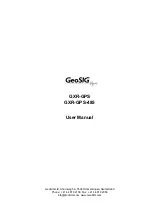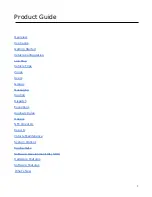
GNS 400W Series Installation Manual
Page 1-13
190-00356-08
Rev. G
NOTE
Unauthorized changes or modifications to any 400W Series product may void the
compliance to required regulations and authorization for continued equipment usage. All
400W Series unit functions are design approved under the TSO.
1.6.2
TSO Deviations
TSO
Deviation
TSO-C34e
1. Garmin was granted a deviation from TSO-C34e to use RTCA/DO-178B minimum software level C instead of
RTCA/DO-178A level 2 to demonstrate compliance for the verification and validation of the computer software.
2. Garmin was granted a deviation from TSO-C34e to use RTCA/DO-160C instead of RTCA/DO-160B as the
standard for Environmental Conditions and Test Procedures of Airborne Equipment.
TSO-C36e
1. Garmin was granted a deviation from TSO-C36e to use RTCA/DO-178B minimum software level C instead of
RTCA/DO-178A level 2 to demonstrate compliance for the verification and validation of the computer software.
2. Garmin was granted a deviation from TSO-C36e to use RTCA/DO-160C instead of RTCA/DO-160B as the
standard for Environmental Conditions and Test Procedures of Airborne Equipment.
TSO-C37d
1. Garmin was granted a deviation from TSO-C37d to use RTCA/DO-178B instead of RTCA/DO-178A to
demonstrate compliance for the verification and validation of the computer software.
2. Garmin was granted a deviation from TSO-C37d paragraph (a)(1) to allow using RTCA /DO-186A instead of
RTCA/DO-186 to specify minimum performance standards.
3. Garmin was granted a deviation from TSO-C37d to allow a 6dB reduction of transmitter power during the
Normal Operating Conditions
– Emergency Operation Voltage as described in RTCA/DO-186A paragraph
2.5.13.1 and RTCA/DO-160C paragraph 16.5.2.1.
4. Garmin was granted a deviation from TSO-C37d paragraph (a)(5) to allow 8.33 kHz channel spacing in
addition to the 25 kHz spacing.
5. Garmin was granted a deviation from TSO-C37d paragraph (b)(1) to allow marking to call our 8.33 kHz
channel spacing in addition to the 25 kHz spacing.
TSO-C38d
1. Garmin was granted a deviation from TSO-C38d to use RTCA/DO-178B instead of RTCA/DO-178A to
demonstrate compliance for the verification and validation of the computer software.
2. Garmin was granted a deviation from TSO-C38d paragraph (a)(1) to allow using RTCA /DO-186A instead of
RTCA/DO-186 to specify minimum performance standards.
3. Garmin was granted a deviation from TSO-C38d paragraph (a)(5) to allow 8.33 kHz channel spacing in
addition to the 25 kHz spacing.
TSO-C40c
1. Garmin was granted a deviation from TSO-C40c to use RTCA/DO-178B instead of RTCA/DO-178A to
demonstrate compliance for the verification and validation of the computer software.
2. Garmin was granted a deviation from TSO-C40c to use RTCA/DO-160C instead of RTCA/DO-160B as the
standard for Environmental Conditions and Test Procedures for Airborne Equipment.
TSO-C113
1. Garmin was granted a deviation from TSO-C113 section 2.1.2 (4) to use RTCA/DO-178B instead of
RTCA/DO-178A to demonstrate compliance for the verification and validation of the computer software.
2. Garmin was granted a deviation from TSO-C113 section 2.1.2 (3) to use RTCA/DO-160D instead of
RTCA/DO-160B as the standard for Environmental Conditions and Test Procedures for Airborne Equipment.
TSO-C146a
1. Garmin was granted a deviation from TSO-
C146a for the requirement to use as a specific ―NAV‖ labeled key.
RTCA/DO-229c Table 2-
5 lists the function ―Access to primary navigation display (Section 2.2.1.4.1)‖ with a label
―NAV‖.
2. Garmin was granted a deviation from TSO-C146a not to implement RTCA/DO-229C paragraph 2.2.3.2.2
which states ―The equipment shall allow the pilot to initiate the missed approach with manual action. It shall be
possible to take this action before crossing the MAWP, in which case the equipment shall automatically initiate
the missed approach procedure at the MAWP.‖
3. Garmin was granted a deviation from TSO-C146a not to implement RTCA/DO-229C paragraph 2.2.4.2.3
which states ―If the aircraft is past the FPAP – (length offset), and the pilot has not already activated the missed
approach, the receiver shall automatically transition to missed approach guid
ance.‖ This requirement is being
eliminated in DO-229D.
4. Garmin was granted a deviation from TSO-C146a from RTCA/DO-229C paragraphs 2.2.4.6.4 and 2.2.5.6.4
not to use the low altitude alerting function when the 400W series unit has TERRAIN enabled and is not in one of
the following states: FAIL, N/A, TEST, or INHIBIT. When TERRAIN is not enabled, or when enabled but the
current state is FAIL, N/A, TEST, or INHIBIT, the low altitude alert described in DO-229C 2.2.4.6.4 and 2.2.5.6.4
is used.
5. Garmin was granted a deviation from TSO-C146a not to implement RTCA/DO-229C paragraph 2.2.1.4.9.c
which states ―BRG to or from a VOR: The bearing is based on the true-to-magnetic conversion at the waypoint
location, using the same magnetic conversion as used to define the path.‖ Instead, the ―user‖ (current) location
will be used. The RTCA/DO-229C paragraph 2.2.1.4.9.c requirement is being eliminated in DO-229D.
Summary of Contents for GPS 400W
Page 1: ...190 00356 08 August 2012 Rev G...
Page 2: ......
Page 125: ...GNS 400W Series Installation Manual Page 6 1 190 00356 08 Rev G 6 RESERVED...
Page 133: ...GNS 400W Series Installation Manual Page B 1 190 00356 08 Rev G Appendix B RESERVED...
Page 135: ...GNS 400W Series Installation Manual Page C 1 190 00356 08 Rev G Appendix C RESERVED...
Page 155: ...GNS 400W Series Installation Manual Page G 1 190 00356 08 Rev G Appendix G RESERVED...
Page 179: ...GNS 400W Series Installation Manual Page H 23 190 00356 08 Rev G Figure H 14 Not Used...
Page 211: ......
Page 212: ......
















































